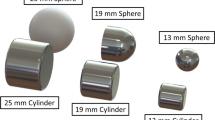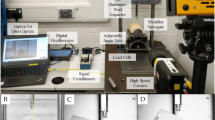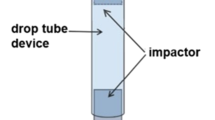Abstract
Knowledge of the biomechanical dynamics of blunt force trauma is indispensable for forensic reconstruction of a wounding event. In this study, we describe and interpret wound features on a synthetic skin model under defined laboratory conditions. To simulate skin and the sub-dermal tissues we used open-celled polyurethane sponge (foam), covered by a silicone layer. A drop tube device with three tube lengths (300, 400, and 500 mm), each secured to a weighted steel scaffold and into which a round, 5-kg Federal dumbbell of length 180 mm and diameter 8 cm was placed delivered blows of known impact. To calculate energy and velocity at impact the experimental set-up was replicated using rigid-body dynamics and motion simulation software. We soaked each foam square in 500 mL water, until fully saturated, immediately before placing it beneath the drop tube. We then recorded and classified both external and internal lacerations. The association between external wounding rates and the explanatory variables sponge type, sponge thickness, and height were investigated using Poisson regression. Tears (lacerations) of the silicone skin layer resembled linear lacerations seen in the clinical literature and resulted from only 48.6% of impacts. Poisson regression showed there was no significant difference between the rate of external wounding for different sponge types (P = 0.294) or different drop heights (P = 0.276). Most impacts produced “internal wounds” or subsurface cavitation (96%). There were four internal “wound” types; Y-shape (53%), linear (25%), stellate (16%), and double crescent (6%). The two-way interaction height by sponge type was statistically significant in the analysis of variance model (P = 0.035). The other two-way interactions; height by thickness and sponge type by thickness, were also bordering on statistical significance (P = 0.061 and P = 0.071, respectively). The observation that external wounds were present for less than half of impacts only, but that nearly all impacts resulted in internal wounds, might explain the observed haematoma formation and contusions so often associated with blunt-force injuries. Our study also confirms the key role of hydrodynamic pressure changes in the actual tearing of subcutaneous tissue. At the moment and site of impact, transferred kinetic energy creates a region of high pressure on the fluid inside the tissue. As a result of the incompressibility of the fluid, this will be displaced away from the impact at a rate that depends on the velocity (or kinetic energy) of impact and the permeability and stiffness of the polymeric foam and skin layer.





Similar content being viewed by others
References
Zugibe FT, Costello JT. Identification of the murder weapon by intricate patterned injury measurements. J Forensic Sci 1986;31:773–7.
Takaziwa H, Nakamura I, Hashimoto M, Maekawa N, Yamamura M. Toolmarks and peculiar blunt-force injuries related to an adjustable wrench. J Forensic Sci 1989;34:258–62.
Clark EGI, Sperry KL. Distinctive blunt-force injuries caused by a crescent wrench. J Forensic Sci 1992;37:1172–8.
Ohshima T. Forensic wound examination. J For Sci 2000;113:153–64.
Rawson RB, Starich GH, Rawson RD. Scanning electron microscopic analysis of skin resolution as an aid in identifying trauma in forensic investigations. J Forensic Sci 2000;45:1023–7.
Thali MJ, Braun M, Dirnhofer R. Optical 3D surface digitizing in forensic medicine: 3D documentation of skin and bone injuries. J Forensic Sci 2003;137:203–8.
Hernandez-Cueto C, Girela E, Sweet DJ. Advances in the diagnosis of wound vitality: a review. Am J Forensic Med Pathol 2000;21:21–1.
Bonelli A, Bacci S, Norelli GA. Affinity cytochemistry analysis of mast cells in skin lesions: a possible tool in the timing of lesions after death. Int J Leg Med 2004;117:331–4.
Thali MJ, Kneubuehl BP, Zollinger U, Dirnhofer R. A high-speed study of the dynamic bullet-body interactions produced by grazing gunshots with full metal jacket and lead projectiles. For Sci Int 2003;132:93–8.
Jain SK, Bhattachareyya CN, Badonia B, Sing RP. Study of unusual phenomenon of contact firing on gelatine block using .38 Special revolver—forensic importance. For Sci Int 2003;133:183–9.
Knight B. The dynamics of stab wounds. Forensic Sci 1975;6:249–55.
Green MA. Stab wound dynamics—recording technique for use in medico-legal investigations. J Forensic Sci 1978;18:161–3.
Ankerson J, Birbeck AE, Thomson RD, Vanezis P. Puncture resistance, tensile strength of skin. Proc Int Mech Eng 1999;213H:493–501.
Silver FH, Siperko LM, Seehra GP. Mechanobiology of force transduction in dermal tissue. Skin Res Tech 2003;9:3–23.
Shergold OA, Fleck NA. Mechanism of deep penetration of soft solids, with application to the injection and wounding of skin. Proc Roy Soc Lond A 2004;460:3037–58.
Shergold OA, Fleck NA. Experimental investigation into the deep penetration of soft solids by sharp and blunt punches, with application to the piercing of skin. Trans ASME 2005;127:838–48.
Kieser JA, Whittle K, Wong B, Ichim I, Waddell JN, Swain M, Taylor M, Nicholson H. Understanding craniofacial blunt-force injury: a biomechanical perspective. Forensic Path Rev (in press).
Lee R, Gamble W, Meyer M, Manson P. Patterns of facial laceration from blunt force trauma. Plast Reconstr Surg 1996;99:1544–54.
Thali M, Kneubeul B, Dirnhofer R. A skin-skull-brain model for the biomechanical reconstruction of blunt forces to the human head. Forensic Sci Int 2002;125:195–200.
Hamilton J, Sunter J, Cooper P. Fatal hemorrage from simple lacerations of the scalp. For Sci Med Pathol 2005;1:267–71.
O’Callaghan P, Jones M, James D, Leadbeatter S, Holt C, Nokes L. Dynamics of stab wounds: force required for penetrating of various cadaveric human tissues. Forensic Sci Int 1999;104:173–8.
United States of America Department of Defence. Emergency war surgery. 3rd ed. Borden Institute, Washington DC; 2004, p.12–13.
Callister WD. Materials science and engineering. New York: John Wiley; 2007.
Cooper GJ, Townsend DJ, Cater SR, Pearce BP. The role of stresswaves in thoracic visceral injury from blast loading: modification of stress transmission by foams and high-density materials. J Biomech 1991;24:273–85.
Young F. Cavitation. London: Imperial College Press, 1999.
Li QM, Reid SR. About one-dimensional shock propagation in a cellular material. Int J Impact Eng 2006;32:1898–906.
Author information
Authors and Affiliations
Corresponding author
Rights and permissions
About this article
Cite this article
Whittle, K., Kieser, J., Ichim, I. et al. The biomechanical modelling of non-ballistic skin wounding: blunt-force injury. Forensic Sci Med Pathol 4, 33–39 (2008). https://doi.org/10.1007/s12024-007-0029-y
Accepted:
Published:
Issue Date:
DOI: https://doi.org/10.1007/s12024-007-0029-y




